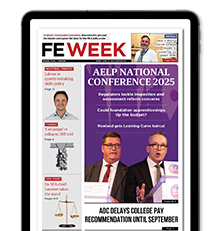The transition to electric vehicles (EVs) presents an unparalleled opportunity for the education sector to lead by example in the shift towards sustainability. With over 200 FE Colleges embedded in the heart of local communities, they are uniquely positioned to spearhead this change. By integrating sustainability across operations, they can enhance their appeal to prospective students and employees.
As reported in these pages last month, the DfE intends to “meet the strategic commitment for all settings to have a climate action plan in place by 2025”. Pressure is building, and arguably there will very soon come a point when climate action plans will undergo the same level of scrutiny as other policies such as safeguarding and health and safety.
But how does this all play out on a practical basis? There are an ever-increasing number of companies specialising in advising on all aspects of reducing carbon emissions focusing on things like heat pumps, solar panels and improved insulation. Rewilding schemes and recycling programmes don’t directly reduce carbon output from a college estate but are important additional options for creating sustainability.
However, one of the biggest practical impacts that will be felt over the next few years is the move to electric vehicles (EVs). With over half (52 per cent) of all domestic transport emissions coming from cars and the transport sector being the largest emitter of carbon in the UK, there has been a focus on driving down emissions from combustion engines and moving to zero-emission vehicles.
While government policy pushed back a ban on the sale of new combustion engine cars to 2035, the zero-emission mandate (ZEV) means a minimum of 80 per cent of all new vehicle sales will have to be EV’s in 2030. Combined with the Labour Party stating they will revert to a complete ban in 2030 as well as manufacturers continuing to remove combustion engine products from their portfolios, the reality of college car parks full of EVs looms.
The reality of college car parks full of EVs looms
Charging at home is an option for some, but those with no off-street parking will have to rely on a network of publicly available charging points. Range anxiety and access to charging facilities are two of the most common barriers to individuals moving to EVs, but the big barrier of cost is rapidly falling: price parity with combustion engine cars is only a few years away.
The rapid rise of EVs on the roads to over 1 million by December 2023 has been helped further by schemes such as the removal of road tax and the car salary sacrifice initiative as well as cheaper running costs. The salary sacrifice has been a very popular route for organisations to offer real value to an employee at no cost to either party. Employers lease the car from a recognised business and the employee pays for it via their gross salary, saving on NI and income tax. Given the pressures on pay within FE, this is a great way of providing employee benefits without impact. It’s also arguably a necessary incentive to compete for prospective employees’ attention.
Charging is also becoming simpler and more accessible, not just for users but for those with the capability to make it available. FE colleges are at an advantage in that they tend to benefit from having the electrical infrastructure to allow charging to take place on site – an incentive for students, staff and visitors alike.
Therefore, the government’s announcement at the start of this month that, through an enhanced Workplace Charging Scheme grant, they will now cover up to 75 per cent of the cost of each charging point (up to £2,500 per point) installed at an FE College should be welcomed and embraced.
The route to Net Zero will take many forms but the barriers will mainly exist around how practical some of the initiatives are to implement. Without adequate charging facilities, uptake (and therefore our ability to reduce overall emissions) will falter.
Strategically embracing EV technology offers a dual benefit: colleges can contribute significantly to environmental sustainability while simultaneously bolstering their attractiveness as forward-thinking, environmentally responsible institutions.
The good news is that the incentives are there, enabling us to jump before we are pushed.

















Your thoughts